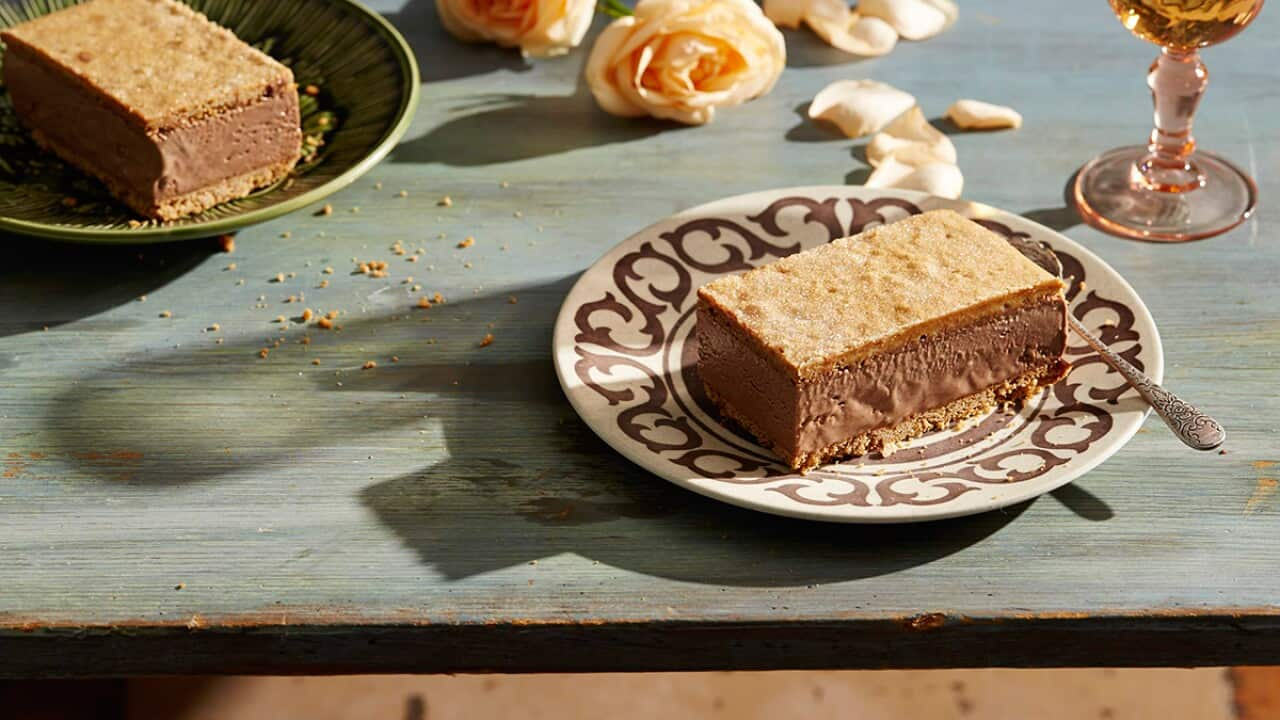serves
8-10
prep
45 minutes
cook
30 minutes
difficulty
Mid
serves
8-10
people
preparation
45
minutes
cooking
30
minutes
difficulty
Mid
level
Ingredients
- 375 ml (1½ cups) milk
- 500 ml (2 cups) cream
- 110 g (½ cup) raw caster sugar, plus extra to sprinkle
- 1 vanilla bean, seeds scraped
- ½ tsp freshly grated nutmeg
- ¼ tsp salt
- 8 egg yolks
- 300 g Mexican chocolate (see Note), chopped
Biscuit (see Note)
- 140 g cold butter, chopped
- 100 g raw caster sugar, plus 2 tbsp extra
- 1 egg yolk
- 1 tbsp golden syrup
- 220 g plain flour
- 50 g desiccated coconut, lightly toasted
- 1½ tsp ground cinnamon
- ½ tsp bicarbonate of soda
- ¼ tsp salt
Freezing time: 8–10 hours
You will need to begin this recipe 1 day ahead.
Instructions
To make the crème anglaise (custard base) for the ice-cream, combine the milk, 375 ml (1½ cups) cream, half the sugar, vanilla bean and seeds, nutmeg and salt in a saucepan and heat until almost boiling. Turn off the heat and allow to infuse for 20 minutes. Bring back to a simmer.
Whisk the egg yolks and remaining sugar until thick and pale. Slowly add the warm milk and whisk gently until combined. Return the mixture to the saucepan and place over a medium-low heat. Cook, stirring, for 7–8 minutes until the crème anglaise reaches 82°C or coats the back of a spoon. Strain.
Meanwhile, combine the chocolate and 125ml (½ cup) cream in a heatproof bowl and place over a saucepan of gently simmer watering. Stir until melted and smooth. Add chocolate to the warm crème anglaise and mix until well combined. Cool to room temperature then refrigerate until chilled. This should take 3–4 hours. Transfer to an ice-cream maker and churn according to the manufacturers instructions. Line a 30 cm x 20 cm x 5 cm slice tin with plastic wrap. Spoon ice cream into the tin so that you have a layer 3 cm thick. Freeze for 8–10 hours or until firm.
To make the biscuit, cream the butter and sugar in an electric mixer on medium speed for 7–8 mins until very pale and the sugar has dissolved. Add the egg yolk and golden syrup and beat until incorporated. Add the remaining ingredients and mix until well combined. Divide the dough in half and roll out between 2 sheets of baking paper into rectangles slightly larger than the ice-cream tin and about 3 mm thick. Gently lift the dough onto baking trays and refrigerate for 20 minutes until firm. Trim the dough to the size of the ice cream tin and sprinkle one of the rectangles liberally with the extra sugar.
Preheat the oven to 160°C. Transfer the cookie sheets to the oven and cook for 15–18 minutes, swapping the trays half way through, until lightly golden but still a little soft. Remove from the oven and allow to cool completely. Wrap in plastic wrap and freeze the biscuits for 1 hour.
To assemble, place the biscuit without the sugar dusting on top of the ice cream and invert. Allow the ice cream to slide out and peel away the plastic wrap. Top the sandwich with the sugar dusted biscuit. Using a serrated knife, gently cut through the top layer of biscuit into 8–10 rectangles. Dip a sharp chef’s knife in hot water and cut down through the ice cream and bottom of the biscuit. Serve immediately.
Note
• Mexican chocolate is available from Latin food stores, online and from gourmet food retailers. If unavailable, substitute good quality 70% dark chocolate.
• If you don’t have an electric mixer you can make the biscuit as you would a shortcrust pastry. The result won't be exactly the same, but it will work nonetheless.
Photography by Benito Martin. Styling by Kristine Duran-Thiessen. Coloured glassware from ; tiles from .
Cook's Notes
Oven temperatures are for conventional; if using fan-forced (convection), reduce the temperature by 20˚C. | We use Australian tablespoons and cups: 1 teaspoon equals 5 ml; 1 tablespoon equals 20 ml; 1 cup equals 250 ml. | All herbs are fresh (unless specified) and cups are lightly packed. | All vegetables are medium size and peeled, unless specified. | All eggs are 55-60 g, unless specified.









